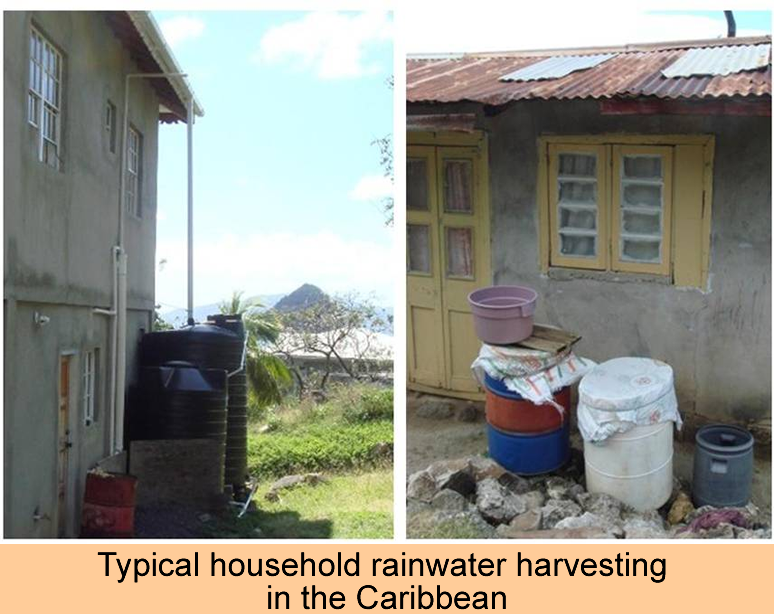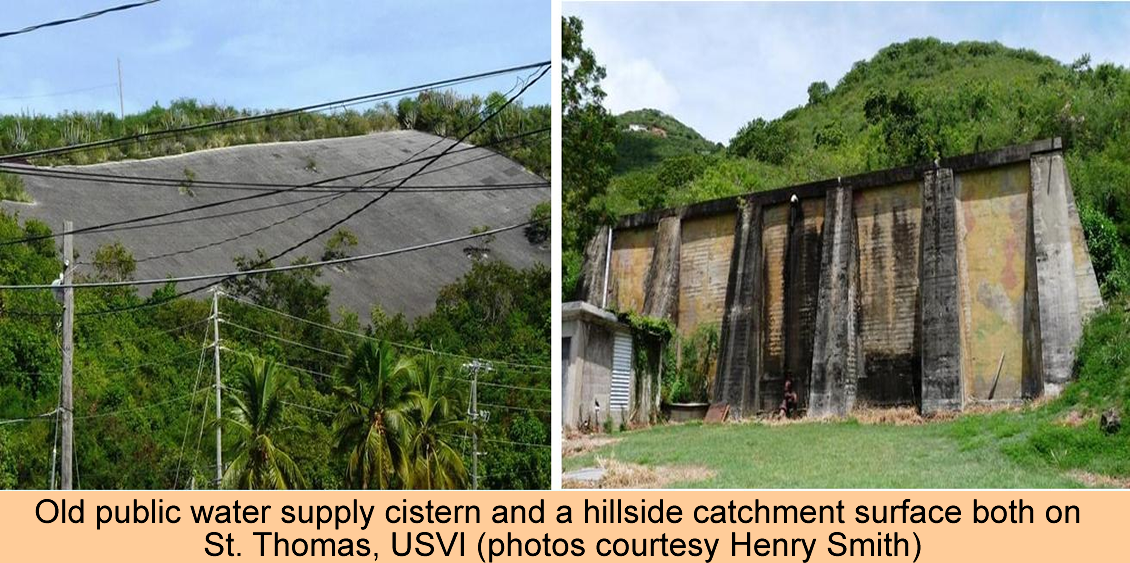





Rainwater harvesting has been used in the Caribbean for at least 3 centuries. Sweeney (1995) suggests that
the technology is appropriate for all areas in the Caribbean but cautions that water quality may be affected by atmospheric po llutants and
material deposited on the catchment surface. Currently it is estimated that approximately 500 000 people in the region at least partially depend on RWH.
The islands that still heavily use rainwater include Antigua and Barbuda, the Bahamas, the US and British Virgin Islands (USVI and BVI respectively), the Turks and Caicos and the Grenadines (of both St. Vincent and Grenada). Rainwater dependent islands are generally characterized by low annual rainfall,
limited land area and intermittent streams. For example Carriacou, in the Grenadines, which relies almost exclusively on rainwater, receives only around 1,200 mm
of rainfall per annum. It is only 34km2
and has no perennial streams (Peters 2006).
In contrast, larger Caribbean islands generally have more available surface water due to larger surface areas and more perennial rivers and lakes.
Higher elevation islands also tend to have greater rainfall levels due in part to orographic rainfall however very steep mountainous islands are
subject to high levels of surface runoff and thus less surface water storage.
llutants and
material deposited on the catchment surface. Currently it is estimated that approximately 500 000 people in the region at least partially depend on RWH.
The islands that still heavily use rainwater include Antigua and Barbuda, the Bahamas, the US and British Virgin Islands (USVI and BVI respectively), the Turks and Caicos and the Grenadines (of both St. Vincent and Grenada). Rainwater dependent islands are generally characterized by low annual rainfall,
limited land area and intermittent streams. For example Carriacou, in the Grenadines, which relies almost exclusively on rainwater, receives only around 1,200 mm
of rainfall per annum. It is only 34km2
and has no perennial streams (Peters 2006).
In contrast, larger Caribbean islands generally have more available surface water due to larger surface areas and more perennial rivers and lakes.
Higher elevation islands also tend to have greater rainfall levels due in part to orographic rainfall however very steep mountainous islands are
subject to high levels of surface runoff and thus less surface water storage.
While rainfall regimes vary across the Caribbean, as a whole, the region exhibits strong seasonality with more than 80% of annual rainfall occurring within the rainy season usually from May to December. Thus, there may be temporal variation in rainwater usage, with peaks during the dry season when rainwater is used to supplement other water sources. Rainwater usage can also vary b ased on community characteristics. Rural areas tend to have more RWH systems because of the distance from public water supplies. In Jamaica for example, it is suggested that more than 100,000 people especially in the rural areas of that country, rely to some extent on rainwater. Sweeney (1995) suggests that in St. Lucia RWH is rarely used in urban areas, is moderately used in rural areas but is heavily used in area not serviced by the public water system. Within individual communities, older households are more likely to have RWH systems as exemplified by New Providence in the Bahamas. On islands like Carriacou rainwater is the only water supply so it is used for everything, from drinking to irrigation. In other parts of the Caribbean rainwater may be used for gardening or laundry with the public water supply reserved for drinking. In Jamaica, a few hotels use RWH as a supplementary water supply which reduces water utility costs up to 35%. In the Bahamas rainwater is also used as a supplementary supply for large apartment buildings, hotels and restaurants.
ased on community characteristics. Rural areas tend to have more RWH systems because of the distance from public water supplies. In Jamaica for example, it is suggested that more than 100,000 people especially in the rural areas of that country, rely to some extent on rainwater. Sweeney (1995) suggests that in St. Lucia RWH is rarely used in urban areas, is moderately used in rural areas but is heavily used in area not serviced by the public water system. Within individual communities, older households are more likely to have RWH systems as exemplified by New Providence in the Bahamas. On islands like Carriacou rainwater is the only water supply so it is used for everything, from drinking to irrigation. In other parts of the Caribbean rainwater may be used for gardening or laundry with the public water supply reserved for drinking. In Jamaica, a few hotels use RWH as a supplementary water supply which reduces water utility costs up to 35%. In the Bahamas rainwater is also used as a supplementary supply for large apartment buildings, hotels and restaurants.